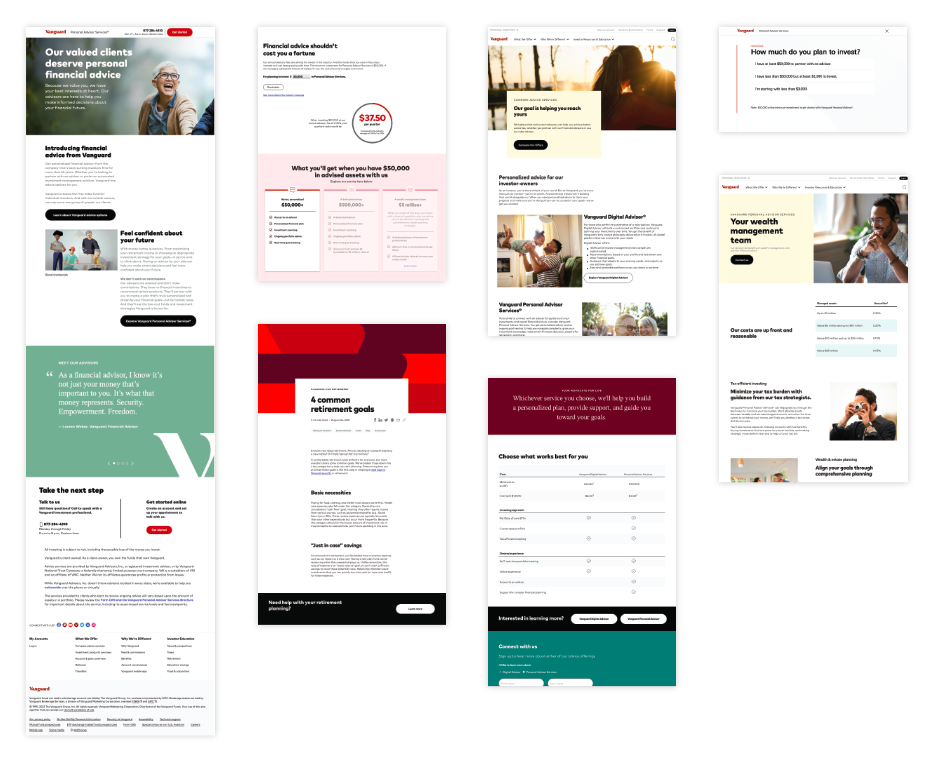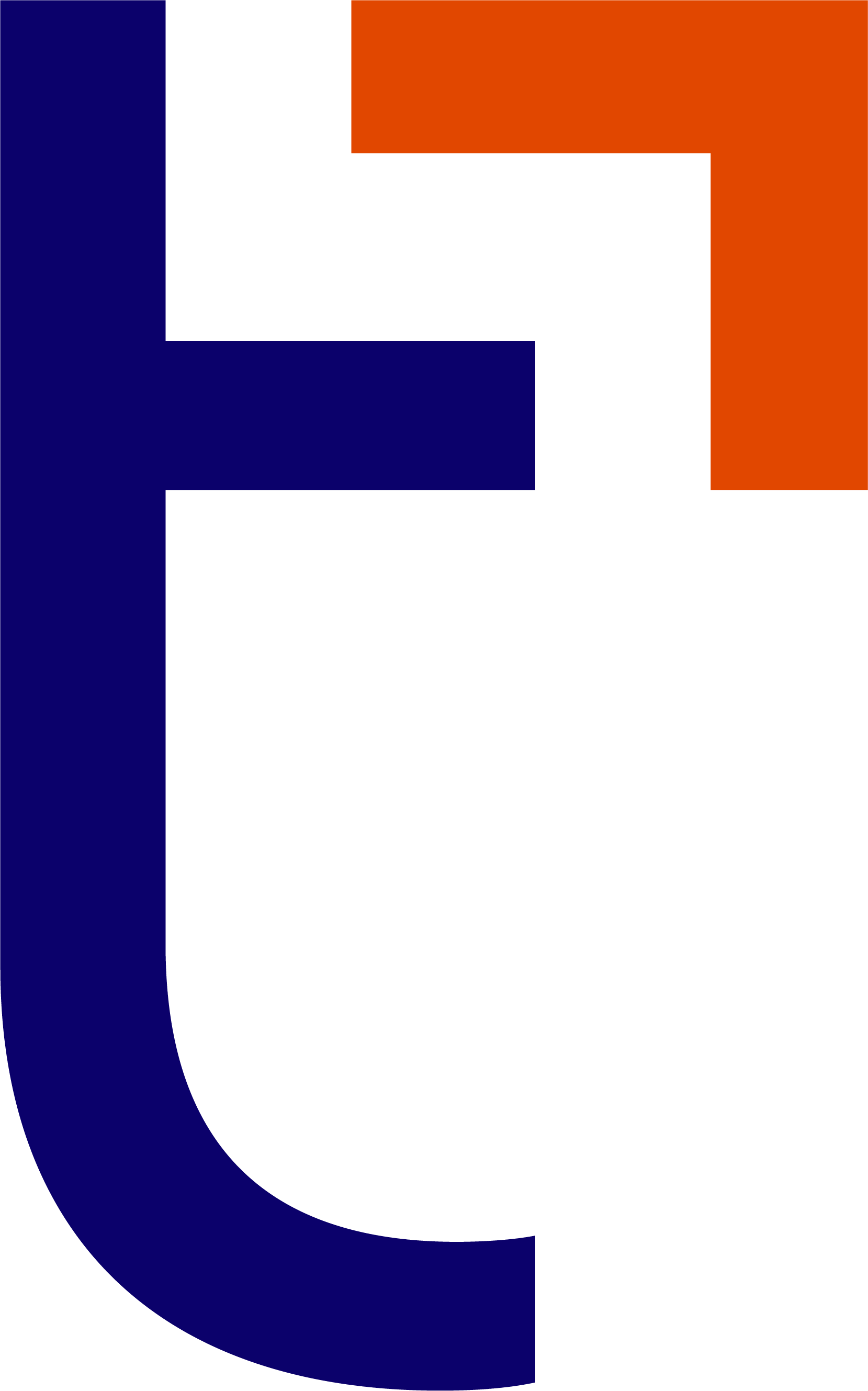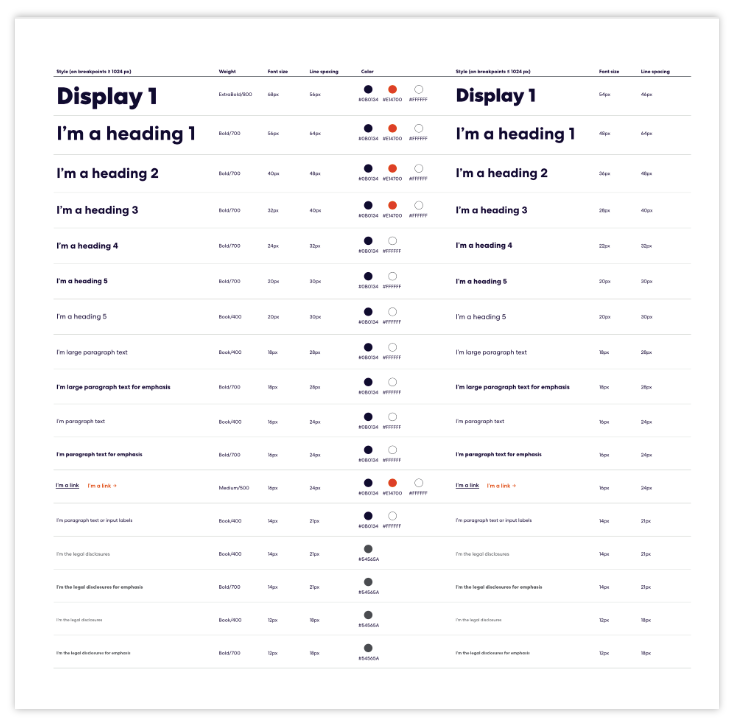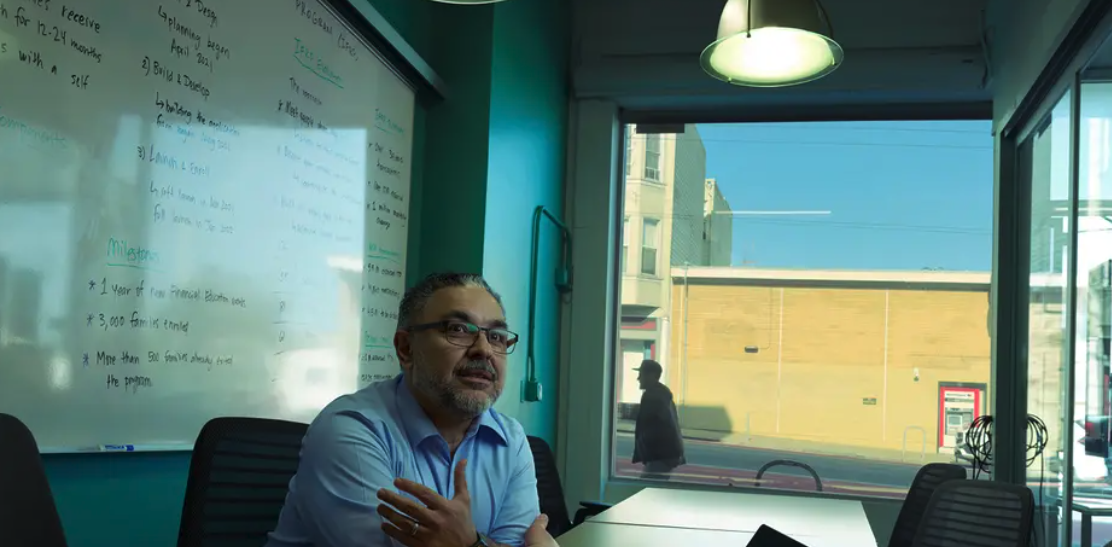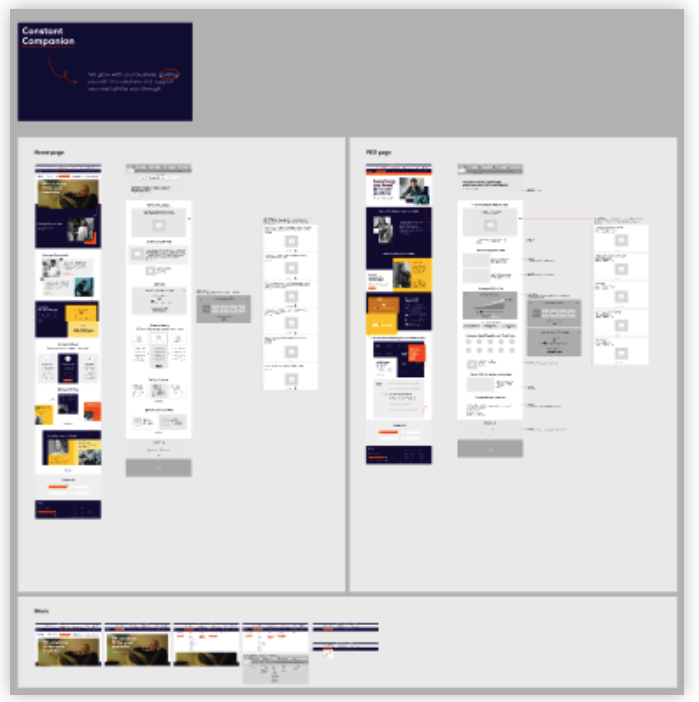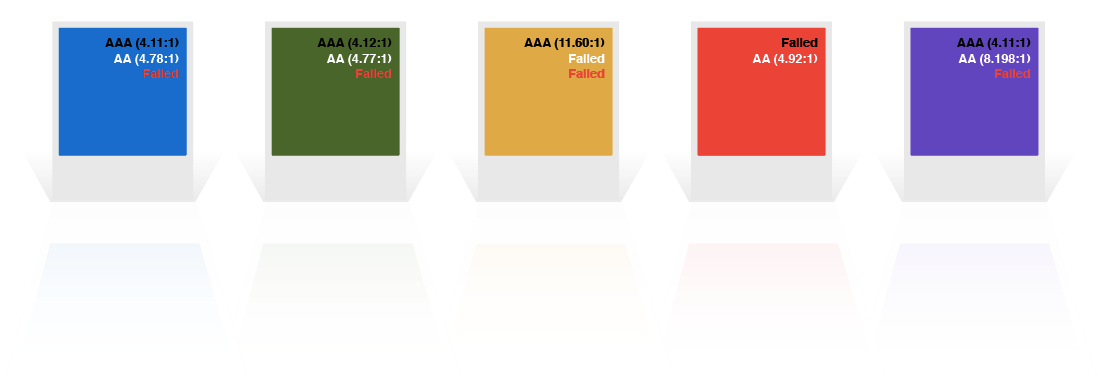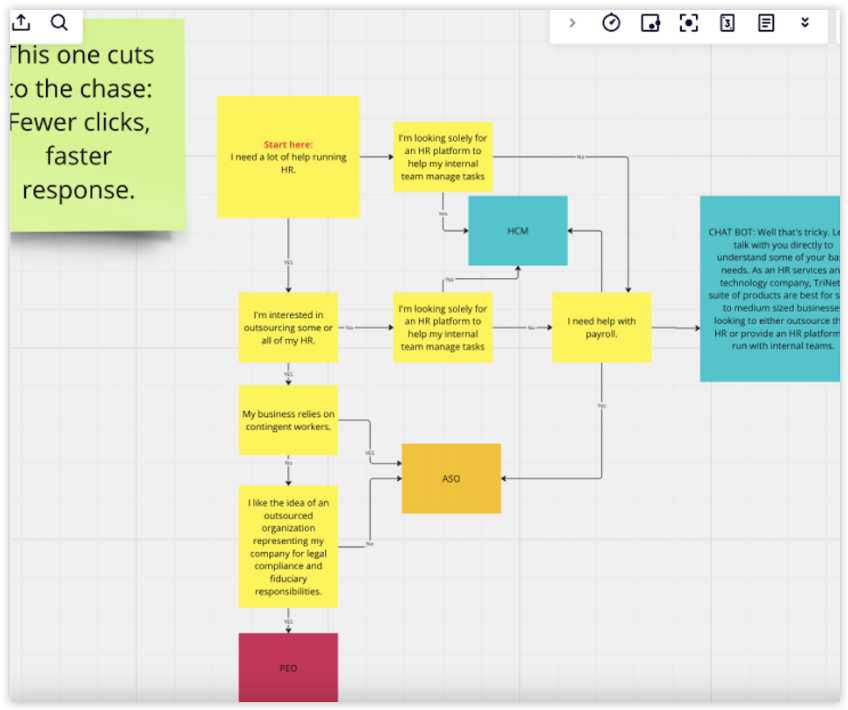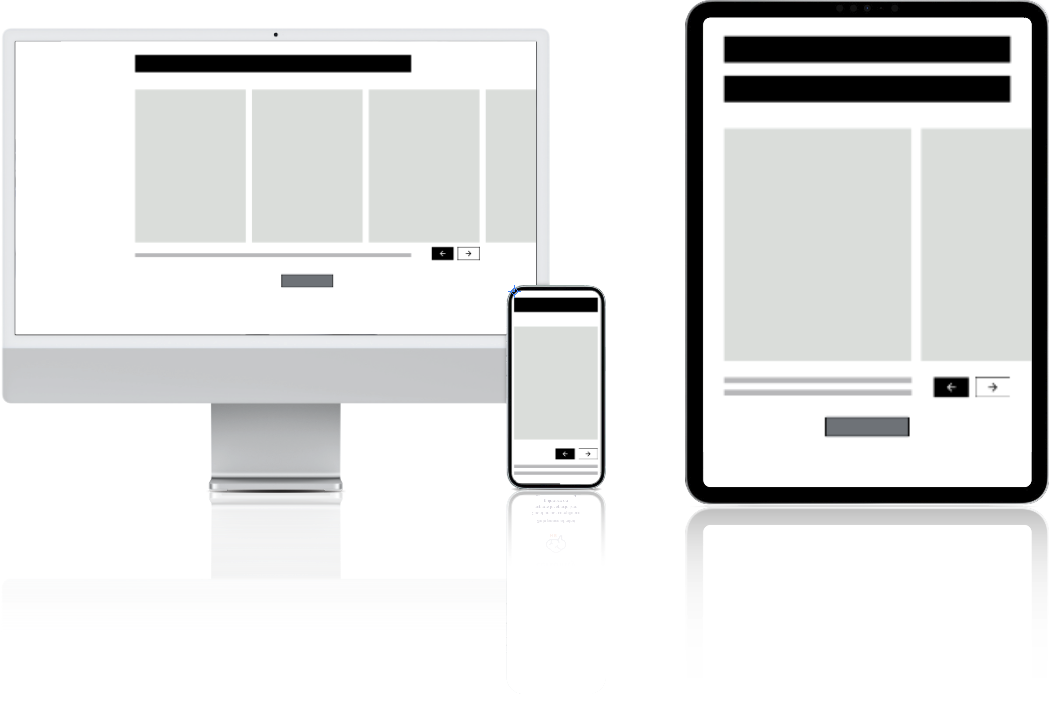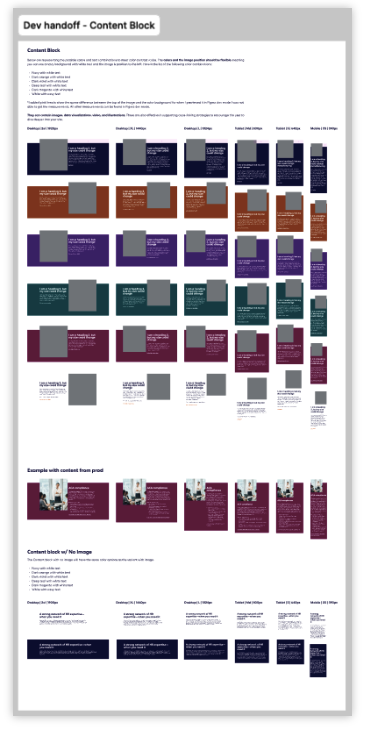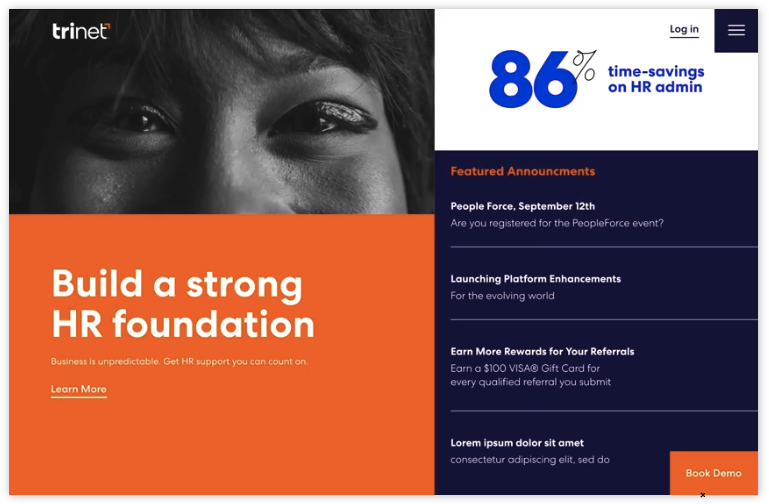TriNet
Director,
Web Strategy
2022-2024
Dublin, California
Remote
In February 2022, I was hired and given the strategic mandate of assembling a cross-functional team capable of conceiving, executing, and sustaining a cutting-edge website for the growing organization.
Later that year, TriNet successfully acquired Zenefits, an innovative HRTech disruptor renowned for its cutting-edge SaaS product. Zenefits had masterfully implemented a Product-Led Growth (PLG) strategy, offering a seamless and immediate buying experience through their online platform.
This opportune acquisition served as a catalyst for a strategic rebranding initiative, a complete restructuring of the product and service ecosystem, the formulation of a fresh go-to-market strategy, and the seamless integration of Zenefits' exceptional capabilities.
Due to timing and resources, we decided to launch in two phases. First would be the new logo and associated brand campaign. Second would be a complete overhaul of the website.
SUCCESS STORY
Integrating a New Vision
Executive Summary
In the dynamic digital landscape, the introduction of a new logo often symbolizes a brand's evolution. However, this transformation extends beyond mere visual appeal; it encompasses a strategic realignment of user experience, especially in complex environments with multiple stakeholders. This case study delves into the challenge of integrating TriNet's new logo into its existing website—a project that not only demanded a fresh aesthetic but also a deep dive into the nuances of the buyer and client journey. By embracing a collaborative approach and championing a unified design system, we spearheaded an initiative that not only enhanced brand coherence but fundamentally improved the onboarding experience, aligning with TriNet's commitment to seamless service.
-
I was the Director of Web Strategy, responsible for the User Experience, UI Design, Content Management System and Development associated with ths effort.
-
The task at hand was multifaceted: introducing a new logo designed by a renowned agency (Siegel + Gale) into TriNet's existing digital ecosystem, amidst a landscape of diverse stakeholder perspectives and without a direct advocate for the buyer experience. This gap was particularly pronounced at the critical juncture where a buyer transitions to a client—a phase pivotal for brand perception and customer loyalty.
-
Recognizing the oversight, our approach was twofold: first, to illuminate the gap in representation for the buyer experience, and second, to propose a holistic system that bridges marketing and product design. Our hypothesis was clear: a cohesive and deliberate design system would mitigate the cognitive dissonance experienced by users during the transition from prospective buyer to onboarded client.
To validate this, we meticulously analyzed current design patterns, pinpointing discrepancies that could potentially derail the user journey. The evidence presented was compelling, underscoring the critical need for a unified design language that encompasses both the aesthetic introduction of the new logo and the functional aspects of the user experience. -
The culmination of our efforts was the unanimous consensus on the necessity for an enterprise-wide design system. This system was envisioned not as a rigid template but as a flexible framework that respects the unique needs of both buyers and clients. Moreover, the project catalyzed the establishment of biweekly cross-divisional meetings, fostering ongoing collaboration between Marketing and Product leadership. This initiative not only ensured the successful integration of the new logo but also set the stage for a redesigned onboarding experience that is both intuitive and welcoming.
-
The TriNet logo refresh project transcended aesthetic enhancement, evolving into a comprehensive strategy that redefined the company's approach to user experience. By bridging the gap between marketing and product design, we not only fostered a sense of unity within the organization but also elevated the customer journey from initial engagement to full integration. This case study exemplifies the power of collaborative innovation in creating a cohesive, user-centric brand experience that aligns with the overarching goals of the organization.
The new TriNet logo, developed in collaboration with Siegel + Gale.
The old TriNet site needed an update, starting with a revised font and color palette to match our refreshed brand identity.
The old TriNet site needed an update, starting with a revised font and color palette to match our refreshed brand identity.
An early acknowledgement of an opportunity to build a cohesive, end-to-end buyer to customer experience led to the conception of an enterprise-wide Design System.
SUCCESS STORY
Iconic Imagery &
Digital Innovation
Executive Summary
The brand launch campaign represented a monumental effort to underscore the significant contributions of small and medium-sized businesses (SMBs) through the powerful narratives of five TriNet clients. This initiative not only aimed to highlight their global impact but also to cement TriNet's commitment to empowering these businesses. The engagement of Annie Leibovitz, an iconic figure in photography, to capture these stories added unparalleled prestige to the campaign. However, this collaboration introduced unique challenges, particularly in the digital execution of a large-scale, multi-channel launch. This case study explores the strategic orchestration required to align Leibovitz's artistic vision with TriNet's digital ambitions, ensuring a seamless and impactful campaign rollout.
-
The collaboration with Annie Leibovitz brought with it a set of logistical and creative challenges. The timing of the photoshoot—closely preceding the campaign launch—necessitated a dynamic and agile approach to digital design and development. The use of placeholder images (FPO) until the final photographs were delivered added a layer of complexity, requiring the design team to anticipate the visual and emotional impact of Leibovitz's work based on her previous shoot with the Queen of England in 2007.
Moreover, Leibovitz's stipulations for the unaltered use of her photographs presented a significant constraint, demanding a design strategy that was both respectful of her artistic integrity and aligned with TriNet's digital presentation standards.
-
Adopting an agile framework, the team prepared for rapid iteration of the digital assets upon receipt of the final photographs. This approach ensured that the design and development phases could adapt quickly, despite the tight timeline.
-
Utilizing the thematic and stylistic elements of Leibovitz's previous work allowed the design team to develop a coherent visual language that could seamlessly integrate the anticipated imagery. This preparation facilitated a smoother transition when the final photos were available.
-
Regular communication and collaboration with Leibovitz's team ensured that all parties were aligned on the campaign's vision and the technical specifications of the digital platforms. This collaboration was crucial in meeting the artist's requirements for the use of her work.
-
Understanding the constraints imposed by the need to use the photographs in their entirety, the digital team crafted a responsive design strategy that could accommodate the images across various devices and screen sizes without manipulation.
-
The successful launch of the "People Matter" campaign marked a significant achievement in the coordination of digital strategy with high-profile artistic collaboration. The unedited, powerful imagery of Annie Leibovitz not only elevated the visual impact of the campaign but also brought authenticity and emotional depth to the stories of TriNet's clients. The campaign's digital execution—across the website, social media, and other digital channels—demonstrated TriNet's ability to innovate within the constraints of artistic integrity and logistical challenges.ription
-
The "People Matter" campaign serves as a testament to TriNet's dedication to celebrating the invaluable contributions of SMBs through a lens of unparalleled artistic and digital excellence. The collaboration with Annie Leibovitz, while challenging, provided a unique opportunity to blend iconic photography with cutting-edge digital strategy, setting a new standard for multi-channel campaign launches. This case study underscores the importance of agility, collaboration, and respect for artistic vision in the execution of digital campaigns that resonate deeply and drive meaningful engagement.
-
The TriNet transformation journey, marked by the integration of a new logo and the "People Matter" campaign, culminated in a grand brand launch event in New York City, where the new visual identity was unveiled. This event was not just a celebration of TriNet's new chapter but also a powerful testament to the stories and contributions of SMBs.
The momentum continued into the next morning as the TriNet leadership team participated in the prestigious tradition of ringing the bell at the New York Stock Exchange (NYSE) on Wall Street.
SUCCESS STORY
Sourcing Global Talent
Executive Summary
In a landscape where talent acquisition transcends geographic boundaries, TriNet's recent venture into the European tech ecosystem underscores a strategic commitment to diversity, innovation, and operational excellence. Following the acquisition of Zenefits, TriNet faced the intricate challenge of sourcing six full-time equivalents (FTEs) from Europe, in alignment with contractual obligations.
This case study delves into the strategic processes, partnerships, and methodologies employed to meet these requirements, culminating in the successful integration of a diverse and highly skilled team within an ambitious timeframe.
-
The obligation to source six specialized roles from the European talent pool presented a multifaceted challenge, requiring a nuanced understanding of the regional tech landscape and a robust strategy for international recruitment. The roles in question—four Fullstack Developers, a Quality Assurance Tester, and a Project Manager—were critical to TriNet's ongoing expansion and needed to complement the existing global team's skills and cultural dynamics.
-
The initiative began with a thorough assessment of TriNet’s organizational needs, identifying the specific competencies and experiences required for each role. This foundational step ensured that the recruitment strategy was precisely aligned with TriNet's operational objectives and cultural ethos.
-
To navigate the complexities of international talent sourcing, TriNet engaged Globalization Partners. This partnership facilitated the recruitment of a highly skilled Tech Lead contractor, instrumental in the vetting process. Utilizing CoderPad, candidates were subjected to live coding challenges, allowing for a real-time evaluation of their technical prowess and collaborative skills.
-
As the representative of TriNet, I played a crucial role in assessing candidates' cultural fit, ensuring they would seamlessly integrate into our diverse and geographically dispersed team. This consideration was paramount, given our existing team spans multiple locations across North America, including Vancouver, San Francisco, Los Angeles, Boulder, Connecticut, Philadelphia, and Bradenton, covering four different time zones.
-
The recruitment drive was a resounding success, resulting in the onboarding of six exceptional professionals within just two months—five based in Poland and one in London. This strategic expansion not only enhances our technological capabilities but also our cultural diversity, enriching our collaborative environment and innovation potential.
-
Incorporating the new team members into our existing operational cadence required careful planning and adaptation to accommodate the wide range of time zones. This effort has further solidified our operational resilience, enabling synchronous collaboration and productivity across our globally distributed team.
-
TriNet’s strategic foray into the European talent market exemplifies our commitment to building a diverse, skilled, and cohesive global team. By successfully navigating the challenges of international recruitment and integration, we have not only fulfilled our contractual obligations but have also strengthened our position as a leader in the global tech industry. This initiative reflects our dedication to operational excellence, cultural diversity, and the continuous pursuit of innovation, setting a new benchmark for global talent acquisition and team dynamics.
“Charles successfully worked cross-functionally at a global scale to ensure the site was ready on time and on budget.”
— Brand Strategist, TriNet
SUCCESS STORY
Redefining Agility
Executive Summary
TriNet's recent website overhaul represents a landmark achievement in digital strategy, showcasing an extraordinary blend of agility, innovation, and customer-centric design. Faced with the formidable challenge of launching a minimum viable product (MVP) within an incredibly tight timeframe of 1.5 months, the project demanded not just the establishment of a scalable, modern infrastructure, but also the seamless coordination of multiple dimensions—ranging from a sophisticated component-based design system to the integration of transactional capabilities for the first time. This case study illustrates the strategic approaches, methodologies, and collaborative efforts that underpinned the successful redesign and migration of TriNet's website, aligning with a new brand identity and significantly enhancing the customer experience.
-
The project was designed with several critical objectives at its core, aimed at revolutionizing our digital presence. First and foremost, we focused on establishing a scalable and modern web infrastructure, laying the groundwork for future growth and innovation. To streamline the page construction process, we created a system of components based on a molecular framework, enabling automation and efficiency in design. Recognizing the importance of our customers' experiences, we embarked on extensive research to deeply understand their unmet needs. This insight fed into a continuous cycle of testing, iterating, and refining the design, ensuring that each step forward was informed by real user feedback. A significant milestone was the migration of 700 pages of content, which involved not just transferring information, but also repurposing and redesigning it to align with the new brand ethos. Finally, we achieved a groundbreaking integration of Zenefits products and introduced a novel transactional capability into TriNet's website, enhancing our service offering and user engagement.
-
To overcome the time constraints, a "follow the sun" agile methodology was adopted, leveraging teams across multiple time zones. This approach ensured continuous progress by handing off tasks between Eastern and Western teams twice daily, significantly accelerating the development cycle.
The value and impact of this method, cannot be overstated. Without this approach, there is no doubt that we would not have met the accelerated timeframe. -
A headless CMS was chosen for its flexibility and scalability, allowing for dynamic content management and distribution across different platforms. Wrike facilitated project management, enabling the establishment of multiple workflows to manage the complexities of the project effectively.
-
The design process was deeply rooted in empathy for the user, employing traditional methods like usability testing and empathy mapping to define opportunities for enhancing the customer experience. This phase was crucial in merging the TriNet and Zenefits websites, ensuring a seamless and intuitive user journey.
-
Ideation sessions led to the production of lightweight prototypes, which were then tested through remote, unmoderated usability tests. The global agile approach allowed for rapid iteration based on real-time feedback, fine-tuning the user experience to meet and exceed customer expectations.
-
The launch of the MVP within the ambitious 1.5-month deadline was a testament to the effectiveness of the global agile approach and the dedication of the TriNet team. The new website not only aligns with TriNet's refreshed brand identity but also introduces a groundbreaking transactional capability, marking a significant milestone in TriNet's digital presence. The integration of Zenefits products has been executed flawlessly, offering a cohesive and engaging buying experience for customers.
-
TriNet's website redesign and migration project stands as a beacon of strategic agility, innovative design, and customer-centric development. By successfully navigating the complexities of modern web development and digital branding within an aggressive timeline, TriNet has not only achieved a significant technological feat but has also set a new standard for executing large-scale digital transformation projects. This initiative underscores TriNet's commitment to leveraging cutting-edge technology and strategic foresight to serve its customers better, showcasing the power of global collaboration and agile methodologies in driving digital excellence.
Creative Ideation with Seigal + Gale
Early iterations of the brand application to the website provided inspiration for the eventual design.
Formative Research
Formative research began with Discovery to develop empathy for the needs of different personas based on the stages of business maturity.
Additional studies included a current state site map evaluation, use case exploration, as well as an evaluation of the brand assets.
An assesstment of screen resolution also helped us to arrive at a responsive approach to design and development.
The quantitiative resolution research led us to developing responsive modules with the layout reshaping in response to the breakpoints that we previously discovered.
Further wireframing, skinning, and A/B testing led to the final design for the site.
Vanguard
User Experience Manager
This dual responsibility model at Vanguard not only challenged us to think differently about how we design and market products but also demonstrated the power of a unified approach. It reinforced the idea that a deep understanding of UX can significantly amplify marketing efforts, providing a richer, more nuanced narrative that truly resonates with users and distinguishes our offerings in the marketplace.
During a transformative period at Vanguard, the User Experience Group uniquely held the dual responsibilities of guiding Product UX as well as overseeing the marketing of those very products. This convergence of roles provided a distinctive advantage in shaping the narrative and strategy behind product marketing, underscoring the symbiotic relationship between understanding a product's design and effectively communicating its value to the market.
Possessing a deep, intricate understanding of the product was instrumental in crafting a marketing narrative that resonated with both precision and authenticity. This comprehensive insight allowed us to identify and highlight specific, nuanced attributes of the user experience—elements that, though subtle, played critical roles in differentiating our products in a competitive landscape. By focusing on these unique features, we could articulate a compelling story that not only informed potential users but also engaged them on a level that transcended traditional marketing approaches.
The interplay between product design and marketing under this model illuminated how a profound grasp of UX can significantly enhance the marketing of a product. The design thinking approach—empathetic, user-centered, and iterative—brought a fresh perspective to marketing strategies, focusing on genuine user needs and experiences. This alignment ensured that marketing messages were not only appealing but also deeply rooted in the real value and innovation embedded in the product experience.
However, the UX approach to product design versus marketing also highlighted important differences. In product UX, the focus is on creating intuitive, seamless experiences that directly engage users, solving their problems, and enriching their interactions with the product. In contrast, marketing UX leans more towards storytelling, persuasion, and emotional connection, aiming to encapsulate the essence of the product experience in a way that captures attention and inspires action. While product UX is about depth and functionality, marketing UX is about narrative and engagement—each requiring a different set of skills and strategies, yet both benefiting immensely from a unified understanding of the user experience.
